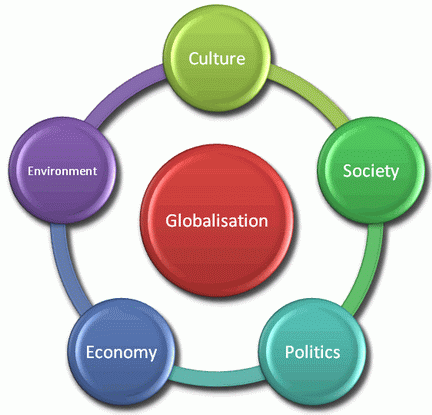Globalization may be the most crucial factor out of the many outside factors influencing your internal business operations. Since the dawn of the digital age, people, cultures, and businesses are becoming more intertwined.
Globalization’s influence on business is complex since it benefits certain groups while harming others. If you plan on conducting or working with international businesses, you need a strong understanding of the basics of globalization in business.
This article presents globalization in the business context, the pros and cons associated with globalization, and a five-step process you can implement today to help prepare your business venture into international markets.
What is Globalization?
The World Health Organization defines globalization as a growing interconnectedness of people and countries that encourages opening international borders for quicker commodity flow. In other words, globalization links economies, cultures, and populations worldwide established by the international flow of trade, technologies, investments, people, and information.


The advancement of globalization and the internet allows businesses to participate in global transactions, eliminating restrictions caused by national borders. Businesses can promote their goods and services to any country with internet access, allowing more sales opportunities. Platforms like YouTube allow you to cultivate a global following, leading to partnerships and other business opportunities.
Businesses that don’t embrace globalization risk creating a competitive advantage within the global market. For instance, Tesla has virtual dealerships that allow global customers to browse their product collection, which helps generate even more revenue opportunities.
The Latest Wave – Globalization 4.0
After World War II and the creation of the internet, a new wave of globalization emerged known as globalization 4.0. This world connects virtually and allows people to conduct business and access files globally. Both the United States and China compete for dominance and strongly influence this economy.


The digital economy is booming in this new wave. For example, Amazon and Airbnb highlight the rise of digital platforms that allow for the connection of market customers in a virtual environment. The internet easily allows global business transactional interconnectedness by using data centers or the cloud, increasing performance and improving the end-user experience.
Even though open economies continuously expose new competition and structural changes that potentially harm businesses, the same economic processes also develop new jobs and opportunities, which improves living standards in the long run.
It’s vital to consider the pros and cons of globalization before deciding to conduct business abroad.
The Pros of Globalization
The advancement of globalization has resulted in various benefits, including:
International Markets
Globalization has resulted in an open international marketplace, which serves anyone with a connection to the internet. As a result, access to new clients and more diversified revenue earnings are possible – for instance, Netflix entered the digital marketplace within 190 countries after its launch date seven years ago.
Diverse Talent
Access to diversified talent gives international organizations a competitive advantage over traditional organizations that only have access to a local and restricted talent pool. A diverse workforce increases resiliency, creativity, innovation, and productivity. For instance, remote positions have a much better chance of attracting global talent.
International Cultures
Access to foreign cultures has never been easier with the advancement of globalization. The flow of diverse people, goods, cuisine, art, and knowledge has connected us with people we would never have known otherwise. Having access to various cultures in business also help employees develop effective intercultural communication.
Advancing Technology and Innovation


Global collaboration is easier to accomplish since we are all connected virtually. Big tech companies such as Apple and Microsoft have various international locations. Employees from anywhere around the world can contribute to innovative ideas to help produce newer technologies.
Universal Standards
Knowledge sharing has led to industry standards. International groups are working towards setting universal standards for labor, employment laws, and tax regulation. For example, the OECD created the Model Tax Convention to help clarify when businesses need to pay corporate taxes.
The Cons of Globalization
At the same time, business leaders must consider the disadvantages associated with globalization before entering an international market.
International Taxes
Leaders must be aware of each country’s unique tax authorities and legislation. Before entering a new market, it is essential to investigate what taxes are due, how to pay, whom to pay, and when. Failure to manage international tax laws can result in fines, penalties, reputation damages, tax audits, and complications.
High Level of Investment
A dedicated team must gather essential resources, including research, revenue, and time. Businesses must be willing to invest significant resources in establishing an effective global strategy to thrive within the global market. For example, a research team can spend considerable time figuring out clients’ needs in various markets, which takes time and money.
Job Cuts
Globalization has made it easier for businesses to outsource services, resulting in massive job losses. For example, Whatsapp started as a small firm with only 35 employees, but it became one of the most popular chat apps in the world. To keep the cost of operations down, Whatsapp outsourced its developers from Russia. Outsourcing removed the opportunities for U.S. employees to work with Whatsapp.
Reduction of Cultural Identities
Cultural identities make up a collective that understands the groups’ values, customs, and traits. Maintaining shared cultural identities is crucial for how group members see and feel about themselves. If a group loses its cultural identity, it will inevitably lose its ability to form personal identities, affecting its psychological functioning.
As you consider the potential risks of globalization and start preparing your business for the international marketplace, certain strategies can help ensure a smoother transition.
Five Steps To Prepare Your Business For Globalization
In theory, doing business on the international market may seem simple, but it is very dynamic and complicated in practice. It’s crucial that you take the time to consider anticipated risks and develop strategies. The point is that there is no such thing as over preparation for globalization.
If you need a refresher on the adaptive cycle and continuous renewal, check out my blog!
Step One: Get Clear on a New Strategic Plan
Venturing into international markets requires a new strategic direction that aligns your mission, vision, and action plans to take advantage of potential strengths and find opportunities in new markets. Creating a new mission, vision, and values that reflect your intention within the international market can ensure proper alignment. A good strategy is to include everyone in the company during strategic planning. The more people are involved in making decisions, the more responsibility they feel to carry out the plan.
Step Two: Conduct Market Research
It’s always best practice to do market research for any business endeavor involving risk. When conducting proper research in your global market, you can determine where you can improve, where your competitors stand, the demand for your services, and the cost of doing international business.
You can make strategic decisions depending on the results of your research. For example, suppose your business offers solar power, and you happen to live in an area with a high demand for solar panels. Your local success doesn’t mean global success – such as in the U.K. market, where the weather is often cloudy and wet. This example highlights why market research is vital for your success.


Step Three: Provide Diversity and Training
Before you worry about things outside of your control, you need to ensure that your business runs smoothly internally. Your employees need to remain educated on cultural sensitivities to thrive in an international market. Offering diversity training programs will enhance intercultural communication and positively influence workplace behaviors.
Diversity training programs can help employees understand and prevent cultural misunderstandings. For instance, business communication styles between Americans and Chinese are night and day. The communication style of Americans is more direct, persuasive, and aggressive, while the style of the Chinese is polite, courteous, and respectful.
Step Four: Develop Your International Communications Plan
A recommendation is to set up a universal file-sharing system to ensure employees can access valuable online resources. Cloud storage apps like SharePoint or Dropbox deliver immediate value for affordable prices. Extra security features, like a private cloud with two-factor authentication, can prevent your business data from being stolen.
It’s also important to consider how remote employees may represent your business. As a result, it’s ideal to set up procedures for managing your remote workforce. Leaders should set clear expectations on the method and frequency of employees’ communication. For example, a weekly lunch and learn would be a great way to maintain open communication among the team.


Step Five: Optimize Your Marketing to Support Multilingual Capabilities
Ensuring that your website, ads, and other marketing materials support multiple languages will help you reach a larger audience when doing business internationally. You can’t predict who will be interested in what your business offers, so taking a proactive approach will pay off in the long run. I had no idea my blogs were reaching people in Russia until someone left me a comment I had to translate manually. So, investing in a translation plug-in would benefit and tend to the needs of my larger audience.
Conclusion
Businesses that aren’t taking advantage of the virtual marketplace are placing themselves at a severe disadvantage. Get ahead of your competitors by first learning how globalization affects your business.
If you decide extending your business into international markets is worth the risks, start preparing to redefine your strategic plan for the global consumer.
Thorough research will help you identify potential opportunities and weaknesses within your market. Use strategic thinking to turn your weaknesses into strengths.
Lastly, you must prepare your business for the international world. The consumer always comes first – that means adjusting your operations to meet their needs.
Once you complete the five steps, your business is ready to thrive globally.
Bianca Cardenas, M.S., Ph.D., is a Fellow in Executive Assessment and Consulting with Leadership Worth Following. Dr. Bianca Cardenas empowers leaders to transcend competition by helping them unlock their people's potential.






















